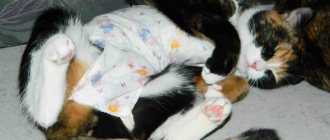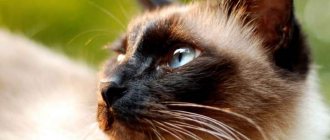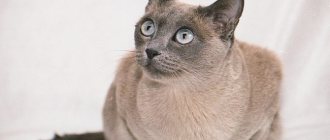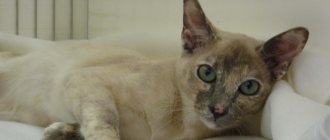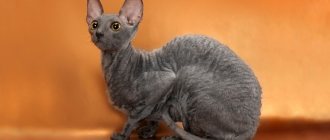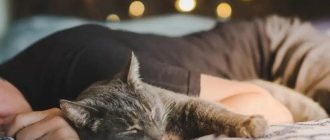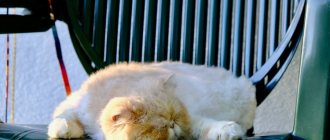When you look at cats with a lot of fingers, you realize that something is wrong here. These multi-toed cats received such unusual paws immediately at birth. This deviation is called polydactyly, a genetic abnormality that can occur in any animal, but it is especially common among cats.
Typically, a cat has five toes on its front paws and four on its back paws. Polydactyl cats, as a rule, have 1-2 more toes on one paw than their usual representatives. In addition, the configuration of these fingers can be different. The polydactyly gene manifests itself in 40-50% of cases and does not depend on the sex of the animal.
However, it has been noted that for a multi-toed kitten to be born, one of its parents must have this feature. Polydactyly is considered a fairly common anomaly among the cat brethren, which does not cause any harm to their musculoskeletal abilities, and even, on the contrary, such a number of fingers is only beneficial for cats.
The only problem noted by the owners of such cats is the more frequent need to trim the claws on additional toes. And also, the offspring of polydactyl cats have a wider and heavier bone structure, compared to the offspring obtained from the most common cats.
It is interesting that residents of New England, where this phenomenon is very common among Maine Coons, consider them to be aboriginals of these lands. There is an opinion that Maine Coons are excellent hunters, and their extra toes make them more dexterous, tenacious and stable, allowing them to move freely through deep snow without falling into it.
It is said that some pets used their miraculous paws to catch fish, which, having caught, they brought to their owners in particularly hungry times. In addition, polydactyl cats were highly valued by sailors for their unique qualities used in catching rats and mice. They were also considered by many travelers to be animals that brought good luck.
Unlike all sorts of other mutations, polydactyly is not a hindrance for cats, and may even be beneficial for them. There are “polydatkty” people who specifically breed such cats and are proud of their pets. There were many famous personalities in the world who had polydactyl cats.
For example, American President Theodore Roosevelt had a polydact cat named Slippers, who became one of the first cats to live in the White House. This cat often became the center of attention at many press conferences and official receptions of those times.
Some polydactyl cats have so-called “mitten paws.” This paw is formed by “extra” toes attached to the inside of the paw. Many cats can move these fingers just like humans. Such representatives of the cat world can easily open any door.
Thanks to the large number of toes on their paws, some cats have entered the Guinness Book of Records. For example, a cat named Jake, owned by Michelle and Paul Contant from Ontario (Canada), had 28 toes.
What is polydactyly?
The term polydactyl cat means that a given cat has more toes than normal.
Most often, polydactic Maine Coons have a sixth toe on the front paws, much less often a fifth toe on the hind paws, while ordinary cats have 5 and 4 toes on the front and hind paws, respectively.
Thanks to this feature, the cat’s paws appear stronger and wider, and their chest is more pronounced. This gives the Maine Coon an interesting and rather unusual appearance. The joints and ligaments of such cats are usually very strong and durable.
Interesting! Polydactyly is not limited to cats. She can meet people too.
This mutation has varieties. So, the extra finger can be located both on the side of the little finger and on the side of the thumb. The last case occurs most often. The paws of such polydactic Maine Coons are very similar to the hands of people, as can be seen in the photo.
Looking into the cat's eyes or seeing her gaze, one could inadvertently spy something from the afterlife; https://tvoykot.ru/pochemu-koshki-luchshe-sobak.html - 11 reasons why cats are better than dogs; Breeding an Abyssinian cat - mating and pregnancy;
The structure of a cat's paws
The light, dancing gait of cats cannot fail to attract attention. Take a closer look: they walk on their toes, like ballerinas! The cat does not step on its heel when walking, the paw remains collected and rounded, and the sharp claws are securely hidden in special “cases.”
The paw is designed in such a way that every finger and every claw is reliably protected. Between the toes, much coarser hair grows than throughout the animal’s entire body, and the base of the toes is protected by elastic, hairless pads.
Nature has reliably protected cat fingers and claws
Cat's paws are perfection conceived and realized by nature and deserve a separate story. All joints and joints are endowed with extraordinary mobility, which not only ensures graceful movements, but also allows, if necessary, to run very quickly, jump high and far, and perform unimaginable somersaults and pirouettes. The motor reactions of this animal are faster and more accurate than those of any mammal.
Flexible and tenacious fingers allow cats to move on any surface
Fingers are especially flexible - each of them seems to live a separate life, moving, bending and unbending independently of all the others. Thanks to this, cats instantly find balance and stay on almost vertical, uneven, slippery, very risky surfaces.
The cat puts its paw on its toes, the heel remains high above the ground
The famous cat toe-walking is complemented by another gait feature called ambling. All cats are pacers: they alternately move all their right paws, and then the two left ones. This allows predators to confuse their tracks, for secret purposes accurately placing one fingerprint on another. In addition, ambling makes the cat more stable and maneuverable - it makes it possible to quickly develop speed and change the direction of movement.
The pacer cats can walk, accurately following the trail.
Infrequently, but such a congenital pathology as shortened toes on the front or hind legs still occurs. An animal with such an anomaly cannot fully move; in the wild or on the street it will inevitably die. A domestic kitten with underdeveloped toes usually adapts to walking on its own, albeit slowly, with its paws tucked under it. Such individuals, of course, should not give birth to offspring - it is better to sterilize them in a timely manner.
The fingers and claws on the front paws of all cats are designed to catch and hold prey - they are much weaker than the striking hind limbs. However, large predators are capable of inflicting significant damage on their prey with a powerful blow from their front paw. By the way, have you noticed which “hand” your cat uses more actively?
In a fight, all four paws are used - but the back ones are much more dangerous
It turns out that the cat family also has its own right-handers and left-handers. Moreover, cats often prefer the left paw, and males - the right. Accordingly, it is on these “priority” paws that the toes of animals are more developed.
The history of the appearance of such deviations
The cause of polydactyly is the inheritance of a mutation gene, but there are several theories about why such a mutation occurred.
One of the most logical is the need to catch animals and move deftly through snow and trees, which is much easier to do with extra fingers.
There is also a belief that Maine Coon polydacts were often used on ship voyages and were a kind of talisman, and their hunting abilities helped fight rats.
In addition, on such paws it was more convenient for them to move around the ship during rocking.
Perhaps it was thanks to such abilities that British cats of this breed were able to enter and reproduce in the territory of modern America.
While ship captains did everything possible to have a Polydactus Maine Coon, the medieval Inquisition mercilessly exterminated them. At that time, any deviation from the norm was considered something demonic, and the increased number of fingers on a cat, which was already considered a guide to the other world, even more so.
Therefore, not many cats with polydacty have survived to this day, and now many nurseries are breeding them.
Do you want a Polydact Maine Coon?
Disadvantages and dangers of polydactyly
In some cases, polydactyly is caused by a gene that leads to the development of other pathologies in the animal. These are deformations of the limbs, improper development of bones, joint diseases, and ingrown claws. Then the animal requires qualified treatment.
One of the dangerous anomalies is the appearance of a three-phalanx thumb. Cats with this pathology often give birth to underdeveloped offspring. Their kittens may have deformed forearms, and therefore such animals are usually sterilized.
What is polydactyly
Polydactus cat paw with six toes
In an anatomical sense, polydactyly means a deviation from the norm, characterized by the presence of more fingers. Regular cats have five toes on their front paws and four on their back paws. Polydactic coons have one extra toe on each paw. Often only the anterior ones undergo mutations. The probability of manifestation of the polydactyly gene in offspring is 45-50%, only if one of the parents has it. But it is impossible to say for sure that polydactic coon kittens will have the same number and arrangement of fingers as their parents. This gene anomaly does not interfere with pets at all.
Types of polydactyly in cats
Two forms should be distinguished:
- preaxial (a thumb is added);
- postaxial (little finger added).
The preaxial form is common in the feline environment. Experts gave the concept of “correct” and “incorrect” polydactics. The “correct” ones include pets with extra toes, positioned like a human’s thumbs. “Incorrect” ones are characterized by physical underdevelopment of the fingers or bones, which leads to curvature of the forearm bones. Cats with this gene are castrated.
Status of polydactyl Maine Coons
“Coon in mittens” - this is how the owners of polydactic coons lovingly call their pets
Although Maine Coon polydacts are currently recognized as a deviation from the norm, the feline systems of the United States officially register them. Such cats take part in exhibitions, but cannot take prizes. Representatives of the American association MCBFA have developed standards for polydacts, and it is possible that they will soon be officially recognized and given the right to compete for champion titles and prizes in all felinological systems.
In our country, polydacty cats are extremely rare. Some consider this individual to be sweet and charming, bringing good luck to the house, while others, on the contrary, are disgusted, considering this mutation a deformity.
It is necessary to understand that polydacty does not in any way affect the physical condition, character and behavior of the pet.
These animals are very close to their owner, affectionate, and playful. You can’t say about them: “a cat that walks by itself.” Owners of cats of this breed claim that their pets have intelligence close to human. The main advantage of this breed is the ability to be loyal and loving.
Cat "in mittens"
Often in the literature you can see that cats with the polydactyly gene are called “mitten” cats. You can get such a kitten by crossing a regular cat and a cat with extra fingers. The autosomal dominant polydactyly gene will be passed on to offspring with a 50% probability . If you hope that the “mitten” will be inherited from ancestors who were once present in your family, you will be disappointed. Only direct inheritance from the carrier of the gene works here.
In one litter, at least one of the polydacts can produce a Maine Coon or regular polydact kitten. Moreover, neither the shape of the paw nor the number of toes are inherited.
The scheme can be briefly described as follows:
1. Parents with polydactylism, both or one - kittens can be:
- with extra fingers
- ordinary
2. A cat from a polydact with the usual number of fingers will never give birth to multi-fingered offspring.
Polydactyly in cats
Cats typically have eighteen toes on their paws: five on their front paws and four on their back paws. It is not uncommon for large breed kittens, such as Maine Coon and Pixie Bob, to be born with polydactyly on only their front legs or on their front and hind legs. The mutation is a defect, although lovers of meowing pets consider it a distinctive feature.
In general, polydactyly is painless and does not cause discomfort to the animal if the fingers are developed normally. By the way, due to the extra large paw toes, they are wide and thanks to this, cats easily move through the snowdrifts without falling into the snow.
In some individuals, additional fingers grow from the side, like the human thumb. Due to this, the paw becomes like a mitten. Owners of such cats claim that with the help of their side fingers, pets deftly open the latches of doors, cabinets and windows.
A ginger cat from Canada named Jake was included in the Guinness Book of Records as the owner of 28 fingers, and in 1974 the cat Mickey Mouse from California with 32 fingers became famous. Ernest Hemingway had many cats, most of which had this mutation. The Hemingway House Museum in Florida is home to approximately 50 cats with polydactyly, and they are believed to be descendants of Hemingway's very first cat, Snowball. He received a cat as a gift from the captain of the ship.
Polydactyly in cats is a genetic mutation that is transmitted through a dominant gene. Therefore, if one of the parents has more toes than normal, then half of the kittens (or less) will be born with polydactyly.
Although the mutation is spontaneous, polydactyls are more common in certain parts of the world. For example, in the southwest of England and the northeast of the USA, eastern Canada.
Caring for cats with polydactyly is no different from caring for regular cats. Once a week you need to check the condition of the nails and trim them as necessary. Due to the location of the fingers, claws can grow into the pads, which in turn can cause pain or infection through the wound.
Interesting! In the old days, sailors took multi-toed cats with them on voyages, considering them to bring good luck and protect the ship during a storm. In addition, they also served as rodent hunters.
How to care for cat paws
All cats instinctively take great care of their paws, and the owners’ task is to help them do this as much as possible. Even a very minor injury - a scuff, crack or scratch on the pads of the fingers can greatly unsettle your pet: he will become irritable or, conversely, depressed, and lose his appetite. In addition, wounds in this area are extremely painful, and sensitive cats suffer greatly from them.
The causes of injury to the pads of the paws and fingers can be very different:
- physical - cuts from sharp objects at home or while walking;
- thermal - cats often get burns by jumping, for example, on a hot stove, and in extreme cold, frostbite occurs on their fingers;
- chemical - if an animal walks in the snow in winter, then the substances that are sprinkled on it may cause a chemical burn on the foot;
- improper nutrition - unbalanced, poor-quality feeding leads to cracking of the skin on the pads and the appearance of weeping ulcers.
Even a minor finger injury can have serious consequences.
Some skin and internal diseases or severe stress can also negatively affect the condition of cat fingers. Such problems require diagnosis and comprehensive treatment under the supervision of a veterinarian.
To eliminate the problem, you need to identify its cause in a timely manner, and for this you should periodically carefully examine your pet’s paws. And at the slightest violation of the skin on the pads and fingers, immediately wash and heal the wounds. It is also very important to constantly monitor the condition of the claws - make sure that they do not grow too long, do not split or get injured.
Trim your cat's claws promptly
An excessively overgrown claw or neglected injuries are common causes of inflammatory processes, which in some cases can even lead to amputation of a finger.
If your cat does not wear down her claws naturally, she will need to have her nails done by herself or by a veterinarian as they grow back. To prevent your pet from damaging upholstered furniture and wallpaper with its claws, just buy him a good scratching post or make one yourself from scrap materials - it’s not difficult at all.
Buy your cat a good scratching post
In polydactic cats, the claws on the “extra” toes grow at a faster rate than on regular toes. This must be taken into account in order to adjust their length in a timely manner.
Video: DIY scratching post - it's easy
Polydactyly. What is this?
Translated from Greek, the word polydactyly means “many fingers.” In fact, this is a natural gene mutation, the result of which is the formation of additional, “extra” fingers. This feature is inherent not only in animals, but also in people. It is noted that this is far from a rare phenomenon, but it was described and officially recognized only in the 19th century.
Regular cats are born with five toes on their front paws and four on their back paws.
Polydactyls have an extra toe on each paw. Maine Coons with this feature have wider paws that differ from the usual shape. Fingers placed to the side make the cat's paw look like a mitten. It looks unusual and extremely interesting. Most often, extra toes can be on the front paws; in rare cases, polydactyl Maine Coons are born with normal front paws and hind paws with more than four toes.
A cat with “extra” toes looks strong, harmoniously built, and will never be thin.
With ordinary care, which does not require special treatment or feeding, the strength of the joints and ligaments is noted.
© shutterstock
Two forms of polydactyly have been noted:
- preaxial, when the thumb is an additional one
- postaxial, an “extra” little finger appears.
The first one is the most common. At the same time, polydacts are divided according to the location of their thumbs. Maine Coons have regular extra toes that resemble a human hand.
The polydactyly gene does not affect the cat’s body in any other way, except for polydactyly, a wide, powerful chest and developed large limbs. Some even note that such Maine Coons have excellent health and psyche, as well as unusually developed intelligence compared to ordinary representatives of cat breeds.
The character, habits and intelligence of the Maine Coon Polydactus are compared with the traits inherent in humans.
Nature and features of the anomaly
Polydactyly, or polydactyly , is an anatomical anomaly that consists of the presence of extra fingers.
Polydactyly is transmitted genetically
It is customary to distinguish the following forms of manifestation of polydactyly:
- preaxial – another thumb (typical of multi-toed cats);
- postaxial – extra little finger (more common in people with polydactyly).
A polydactyl cat does not have problems with the musculoskeletal system; this does not prevent the kitten from leading a full life.
The extra finger is only noticeable visually - the kitten's paws resemble mittens - but this does not interfere with the normal development of the baby.
Polydacts in the history of the breed
By nature, Maine Coons have endurance and strength, and they are excellent hunters. Therefore, the assumption arose that additional fingers were “given” to them by Mother Nature in order to give better stability and tenacity. They help not to fall on the snowy surface, as well as to climb trees.
Polydacts are also considered companions of sailors, ship cats. Extra fingers helped them maintain balance on the deck even during a storm. Since their hunting instinct predominates, catching mice and rats on the ship was their first task. And besides, sailors believed that polydactyl cats brought good luck, so they willingly took them on long voyages. This helped the British Maine Coons spread to the Americas.
© shutterstock
There is another legend according to which Maine Coons, with their strong paws with extra toes, could catch fish in streams. This again confirms the hunting instinct inherent in nature, especially developed in cats of this breed.
If in Britain and America more than the usual number of fingers on a Maine Coon was considered lucky, then in Europe such individuals were exterminated. The Middle Ages are generally marked by hunts for witches and everything that went beyond the ordinary. Unusual cats also fell under the same story; nothing could spare them.
It is noted that almost half of Maine Coons have this mutation. It is believed that this is a kind of gift given to this breed, because it was for this breed that it turned out to be the most successful.
Currently, the polydact population is becoming smaller, so nurseries specializing in their breeding are being created.
Special care
Although multi-toed cats do not have any particular health problems, you as an owner will need to provide careful care for your furry cat's claws and paws. According to Petful, they “often develop an extra claw between the big toe and foot, which can grow into the foot or ball of the foot, causing pain and infection.” To avoid irritation or possible injury, ask your veterinarian for advice on the best and safest way to trim your kitten's nails.
Pay attention to how often your cat licks its paws. Keeping a close eye on your pet's washing habits (multi-toed or not), which may include excessive paw licking or favoring one paw over the other, is a great way to find out if she's okay.
Don't let fear of the unknown stop you from adopting happy, healthy multi-toed cats! They will fill your home with love, friendship, happiness and... a few extra fingers.
Should I buy such a kitten?
First of all, anyone who is planning to have a polydactic cat should understand that the gene mutation only affects appearance and in no way disrupts any body functions. Looking at a photo of a Polydact Maine Coon, we see only a cute, physically strong creature. If you are planning to buy a kitten of this breed, then the number of fingers is unlikely to be an obstacle.
© shutterstock
The only factor may be the desire to perform at various events and competitions, but the inability to do this in a regular breed class. Here it will be important how many fingers a Maine Coon cat has. Multi-toed individuals will never become champions among ordinary representatives of the breed, but will only be able to participate in special groups - a mutation.
You should also take into account the fact that the cost of a Maine Coon polydact will be approximately 1.5-2 times higher than usual. This is due to the fact that today a cat of this breed with “extra” fingers is exotic. Its popularity is only gaining momentum; at times it has faded.
Now again, nurseries are actively breeding the population and widely advertising it. Therefore, those who want to purchase a regular Maine Coon can be offered this option.
All breeders of such special cats claim that it is easy to establish good, truly friendly relationships with them, thanks to his natural intelligence and tenderness. Give them your warmth and care, and a faithful friend will always be devoted to you. Remember that the main advantage of polydactyl Maine Coons is the ability to love and be loyal!
What is the difference between the appearance of a polydactyl Maine Coon?
In addition to the fact that they are distinguished by an increased number of toes on their paws, other external features are noted:
- large body, broad-boned, elongated, with good, but not pronounced muscles, wide chest,
- strong limbs of medium length, proportional, slender, covered with thick hair, 6 toes on the front paws, 5 or more on the hind paws (up to seven),
- massive head, well-defined strong chin,
- large ears pointed upward,
- large eyes, expressive, proportional to the features of the muzzle, eye color is often blue,
- The coat color does not differ from ordinary representatives of this breed.
